Relics of the Hindu Kingdom – Indonesia is a country that has a lot of wealth. In fact, in terms of its own culture, Indonesia can be said to be very rich.
If we go back to studying history, Indonesia is one of the countries that once had a kingdom with a Hindu religion. Until now, evidence of the relics of the Hindu kingdom has also been abundant.
The relics of the Hindu kingdom are currently used as a medium of learning from generation to generation until they become a form of cultural heritage. Of course, we as a good nation must continue to maintain what has been left by our ancestors.
The splendor of every heritage of the Hindu kingdom makes us even more able to think that long ago our ancestors were able to make something so amazing, beautiful, amazing, complex that it had cultural elements that could be used as a lesson for the next generation.
In this article, we will discuss some of the relics of Hindu kingdoms that have been found in Indonesia. Therefore, if you are curious about the relics of the Hindu kingdom, here is a complete explanation.
Characteristics of Hindu Temples
One form of heritage of the Hindu kingdom in Indonesia is the temple. There are many temples that stand firm and have their own beauty with Hindu patterns and exist in Indonesia. In fact, some of you may already know what these temples are.
Interestingly, actually in Indonesia there are not only temples relics of the Hindu kingdom. But there are also temples with patterns of other religions such as Buddhism. So, of course, Hindu temples will have different characteristics from Buddhist temples.
Therefore, before we go further in knowing what are the relics of the Hindu kingdom. It would be better, if we also know what are the characteristics or characteristics of Hindu temples, here are their characteristics.
- At the entrance to Hindu temples there is usually a kala head which is equipped with the lower jaw.
- Hindu temples usually have a slimmer shape.
- In general, Hindu temples are grouped or complex in that there are several temples within the area and the main one will be at the back of the ancillary temples such as the Prambanan Temple.
- Hindu temples will usually have a statue of the goddess Trimurti
- The top of a Hindu temple is usually in the shape of a pearl
- Hindu temples in general will have three building structures. Starting from Bhurloka, Bhuvarloka, and Svarloka
- Hindu temples will usually have a function as a burial place for kings and places of worship to the gods in Hindu religious beliefs.
Some Relics of the Hindu Kingdom in the Form of Temples
Historical relics with Hindu motifs such as temples, inscriptions to literary works have been found in Indonesia. For example, Prambanan Temple and various other temples that are spread out all over Indonesia.
The existence of relics in various parts of Indonesia cannot be separated from the long history of the process of spreading Hinduism in the archipelago in the past. In fact, until it could form the same empire spread across various regions of the archipelago.
Starting from the Kutai Kingdom which turned out to be the oldest Hindu kingdom because according to history it had been established since 500 AD to the Majapahit Kingdom which was established in 1292 AD which at that time had a war leader who was so dashing, strong and famous, namely Gajah Mada.
Until now, we can still enjoy the existence of the legacy of the Hindu kingdom as a learning medium. Below, there are some relics of the Hindu kingdom which you can read in full.
1. Prambanan Temple
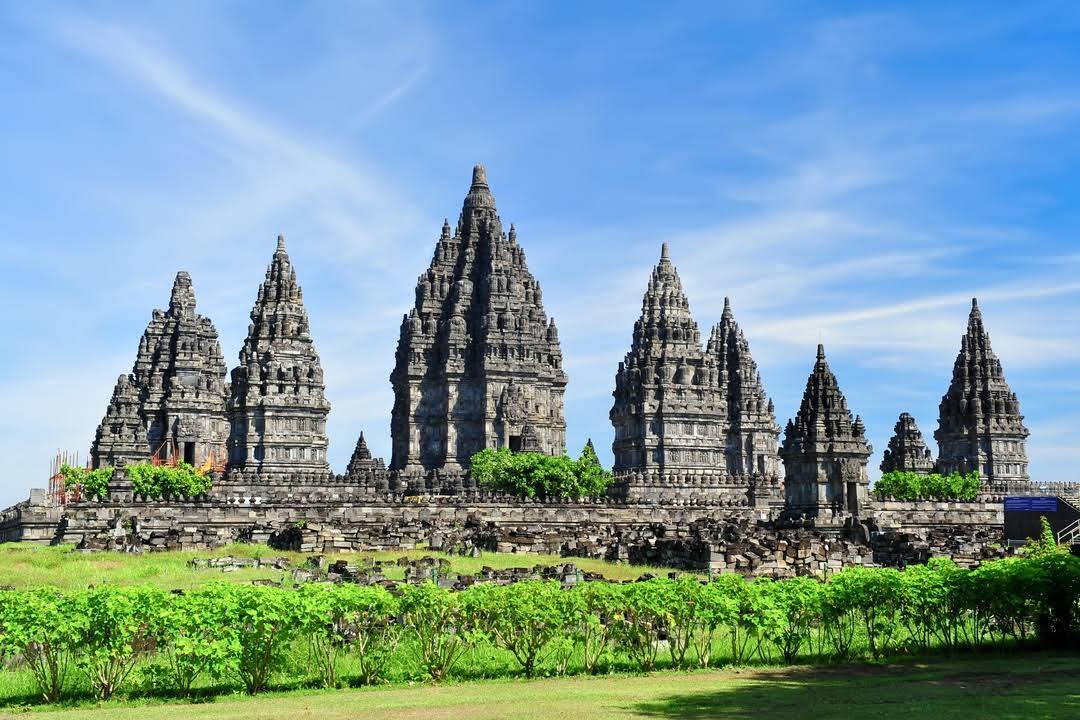
Prambanan Temple is a Hindu temple located in the village of Prambanan or on the border of Central Java and Yogyakarta. Prambanan Temple is estimated to have been built since the 9th century AD.
The establishment of Prambanan Temple is used for the existence of the Trimurti such as Brahmins, Vishnu and Shiva. Actually, Prambanan Temple has the original name Siwagrha which comes from Sanskrit with the meaning of Shiva’s House when seen from the Siwagrha Inscription.
Prambanan Temple also has a Shiva Mahadeva event with a height of about three meters in the main hall or garbagriha.
This shows that Prambanan Temple prioritizes the god Shiva. Interestingly, Prambanan Temple is also the most beautiful temple in Southeast Asia. The architecture of Prambanan Temple is seen as a tall and slender building, the same as in other Hindu temples. In addition, UNESCO has also determined that Prambanan Temple is one of the world heritage sites along with the Buddhist Borobudur Temple.
The main temple in the Prambanan temple complex has a size of 47 meters which is in the middle of other small temples. It is estimated that Prambanan Temple has existed since 850 AD when viewed from the Siwagrha Inscription, which subsequently developed during the Medang Mataram Kingdom during the reign of Balitung Maha Sambu.
2. Dieng Temple
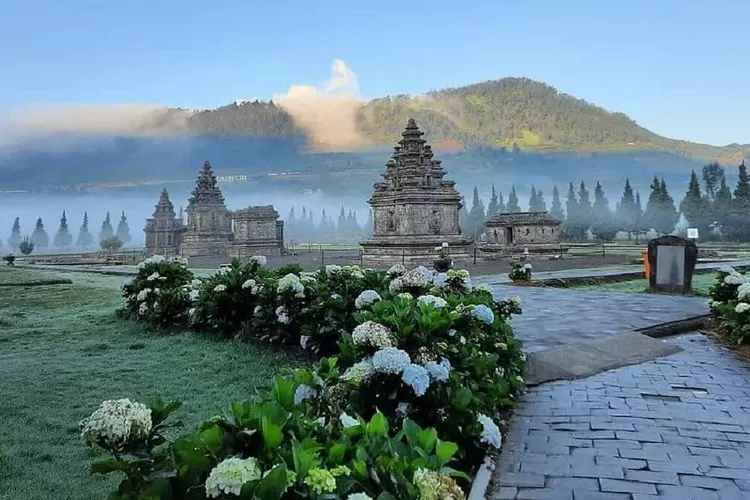
Next, there is the Dieng Temple which is also included in one of the temples with a Hindu style. Dieng Temple is a 7th century masterpiece building from the Sanjaya Dynasty. Dieng Temple itself is located on the Dieng Plateau, Central Java.
Previously there were around 400 temples in the Dieng Temple complex area. This makes the Dieng area often referred to as the Javanese Hindu Temple Complex. Even so, the number of 400 temples has begun to decrease to only a few temples.
Dieng Temple has northern Javanese architecture which is almost similar to Gedong Songo Temple and Clown Temple in East Java as well as Cangkuang Temple and Bojongmenje Temple in West Java. The characteristics of this architecture are simple style, few ornaments and relatively small size.
Evidence in the form of inscriptions found in the area shows that the Dieng Temple complex has existed since the 8th and 9th centuries AD. The construction of the Dieng Temple is used as a form of embodiment of the community’s devotion to Lord Shiva and Sati Shiva or Shiva’s wife.
Of the 21 existing buildings in the Dieng Temple complex, they are divided into 5 groups. Where the 4 groups of temple buildings are in the form of ceremonial sites or places of worship as the Arjuna Temple Group (Pandawa 5), Gatotkaca Temple Group, Bhima Temple Group, Dwarawati/Parikesit Temple Group, Magersari Temple Group.
Then, for the fifth group in the Dieng Temple complex, they are buildings used as residences or what can be called settlement sites, where currently only ruins remain in the Arjuna temple complex area.
It should also be noted that another temple complex was recently discovered, namely Setyaki Temple.
3. Gedong Songo Temple
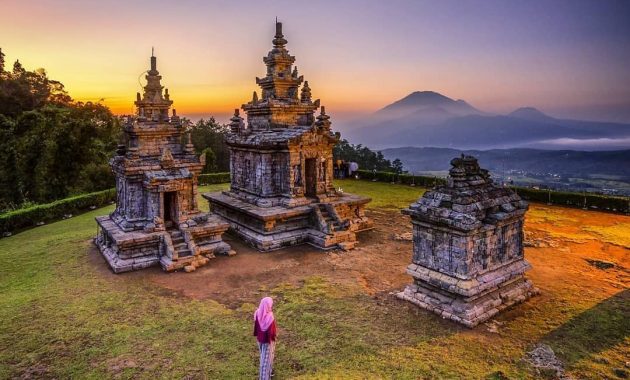
Gedong Songo Temple is one of the cultural heritages that has a Hindu style. Gedong Songo Temple itself is located in the village of Candi, Bandungan, Semarang Regency, Central Java province.
Like Dieng Temple, Gedong Songo Temple is also one of the relics with a Hindu style which is located on a plateau around 1,200 meters above sea level. More precisely, Gedong Songo Temple is located on the slopes of Mount Ungaran.
With this altitude, the air temperature in the Gedong Songo Temple area is quite cold, which is between 19 and 27 degrees Celsius. The 9 temples in the Gedong Songo Temple complex are located in different places with quite a distance. Even so, Gedong Songo Temple is still able to offer such beautiful natural scenery.
Currently, Gedong Songo Temple has several other tourist attractions such as a hot spring bathing area from sulfur-containing springs, camping areas, horseback riding tours and several other facilities.
In 1804, Raffles managed to find the Gedong Songo Temple for the first time. Gedong Songo Temple is also included as a Hindu cultural heritage from the 9th century Syailendra Dynasty or around 927 AD.
4. Asu Sengi Temple
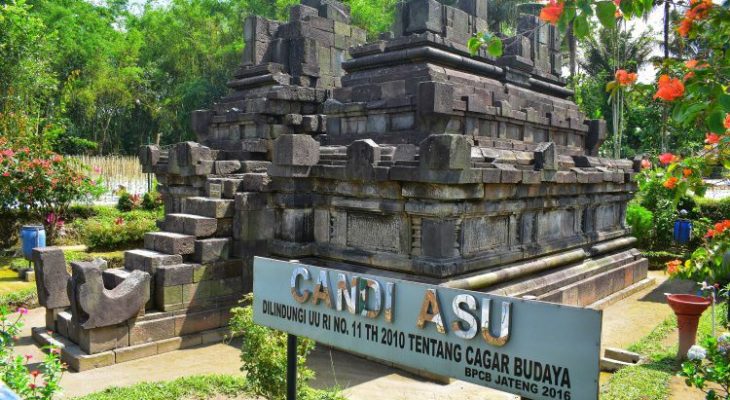
Asu Sengi Temple is a Hindu-style temple located in Candi Pos Hamlet, Sengi Village, Shaman District, Magelang Regency and is located on the western slopes of Mount Merapi or on the banks of the Tlingsing Pabelan River.
The local community gave the name Asu Sengi Temple when they first discovered the Lembu Nandi statue, but it was in a damaged condition and more like the shape of a dog or if in Javanese it is called asu.
Besides having an amazing view, Asu Sengi Temple is also often used as a place to hold traditional ceremonies for the local community.
5. Umbul Temple
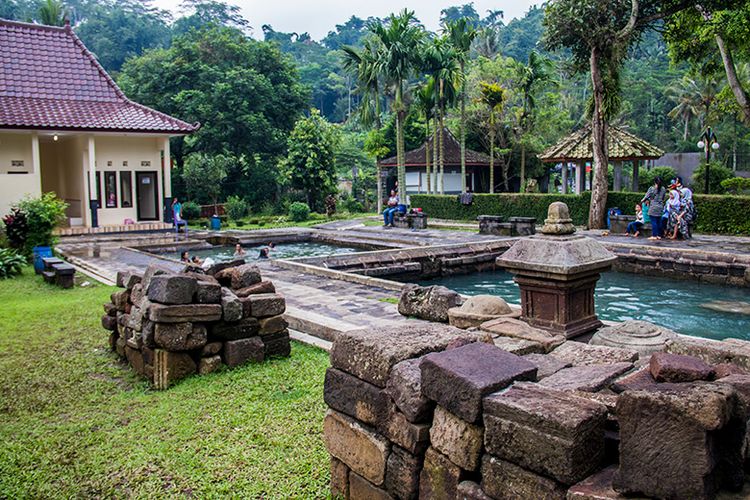
Umbul Temple is located in Candi Umbul Hamlet, Kartoharjo Village, Grabag District, Magelang Regency. Where the Umbul Temple was included as a relic of the Hindu Mataram Kingdom during the Syailendra dynasty.
Apart from offering a very cool atmosphere and views of the rice fields that are so beautiful. Umbul Temple also has two large and small ponds which are often used as bathing places by visitors.
6. Clero Temple
Next is Klero Temple which is also a Hindu temple and is located in Ngentak Lor, Klero, Tengaran District, Semarang Regency. The location of Klero Temple is actually quite strategic and easy to find because it is on Jalan Raya Salatiga-Solo and not far from the Tengarang market.
Even so, the existence of Klero Temple is quite rarely visited. Until now, the existence of Klero Temple is very well maintained and well maintained. Having a relatively small size makes visitors not easily tired when visiting Klero Temple.
7. Pringapus Temple
Pringapus Temple is located in Temanggung, Central Java and is currently also a tourist destination in the area. Pringapus Temple is located in an area that is still well maintained so that the environment allows visitors to capture the moment they are in this tourist attraction.
At certain times, visitors can see such a beautiful view from Pringapus Temple. The existence of Pringapus Temple is often used for local community traditional ceremonies and of course visitors can see it.
8. Ngempon Temple
Ngempon Temple often referred to as Candi Muncul is one of the relics of the Hindu kingdom. According to the story, Ngempon Temple was formerly used as a training ground used to train people to become masters or mpu.
Even so, currently the existence of Ngempon Temple is relatively empty of visitors. In the Ngempon Temple area there is also the Petirtaan Derek Hot Spring that visitors can visit. Ngempon Temple is located in Klego, Ngempon, Kec. Bergas, Semarang Regency, Central Java.
9. Jago Temple
Judging from the information in the Negarakertagama and Pararaton books, Jago Temple has the original name Jajaghu. The name Jajaghu itself means Majesty, just as the main purpose of the construction of Jago Temple was used to honor King Sri Jaya Wisnuwardhana who is also King Singasari who adheres to the Shiva Buddhist religion.
Shiva Buddhism itself is a flow of blending Hindu and Buddhist teachings. The construction process of Jago Temple itself uses andesite rock material. Then, Jago Temple also has Kunjarakarna and Pancatantra reliefs. Jago Temple is located on Jl. Wisnuwardhana, Roggowuni, Overlapping, Kec. Tumpang, Malang Regency, East Java.
10. Gupolo Arca Temple
Unlike the heritage sites of previous Hindu kingdoms, Arca Gupolo Temple is a heritage site with Hindu roots consisting of a collection of 7 statues. The name Gupolo itself was given by local residents to the Agasta statue which is also one of the statues on the Gupolo Arca Temple site. Close to Arca Gupolo Temple, there is a clear spring that never dries up during the long dry season.
11. Sukuh Temple
Furthermore, there is the Sukuh Temple which is also included in the list of temples with a Hindu style. The temple which is located in the Tambak area, Berjo, Kec. Ngargoyoso, Karanganyar Regency, Central Java has a pyramid-like shape.
Not only that, the article in Sukuh Temple has reliefs and statues that depict human genitalia explicitly. In 1995, Sukuh Temple was proposed to UNESCO as a world heritage site.
Relics of the Hindu Kingdom in the Form of Inscriptions and Books
Apart from temples, there are also relics from the Hindu kingdom in the form of inscriptions and books, including:
1. The Kutai Inscription
The Kutai inscription is one of the legacies of the next Hindu kingdom. Where the Kutai Inscription or Mulawarman Inscription is a relic of the Kutai Kingdom in East Kalimantan. This inscription was first discovered near the headwaters of the Mahakam River which is also part of the Kutai Kingdom. The inscription itself is a document or certain important information which is written on stone or metal media.
Then, for the Kutai Inscription itself, it contains the story of King Mulawarman who gave many cows to the Brahmins. The inscription states that King Mulawarman was the son of Aswawarman and grandson of Kudungga. While the language used in the Kutai Inscription is Pallawa letters and Sanskrit.
2. The Ciaruteun Inscription
The Ciaruteun inscription is also one of the relics with a Hindu style. The Ciaruteun inscription itself was found on the banks of the Ciaruteun River, near the mouth of the Cisadane River, Bogor, West Java. Where the Ciaruteun Inscription is believed to be a relic from the Tarumanegara Kingdom. Then the writing of the Ciaruteun Inscription itself uses Pallawa letters and Sanskrit.
3. Bharatayudha book
The Bharatayudha Book is a work of literary art created by Mpu Sedah and Mpu Panuluh. Where the Bharatayudha Book is a literary work that existed in the era of the reign of the Kingdom of Kediri. The Bharatayudha book was completed in 1079 Saka or on 6 November 1157 AD.
The contents of the Bharatayudha Book are sourced from the Mahabharata which describes the victory of the Pandavas over the Kauravas in Padang Kurusetra or better known as the Bharatayudha War.
4. Hariwangsa Book
The Hariwangsa Book is a work of literary art written by Mpu Panuluh in 1135 to 1157 AD. The Hariwangsa Book is also included in historical heritage with a Hindu style that existed during the reign of the Kingdom of Kediri. The Hariwangsa Book itself tells of King Kresna, the incarnation of the god Vishnu who married Dewi Rukmini from Negeri Kundina who is also the incarnation of Dewi Sri.
Closing
Well, that’s a review of some of the relics of Hindu kingdoms in Indonesia. By reading the information above, we have become more aware of the history in Indonesia.
If you want to find books about kingdoms in Indonesia, then you can get them at sinaumedia.com. Reading lots of books and articles will never hurt you, because Sinaumed’s will get #MoreWithReading information and knowledge .
Author: Hendrik Nuryanto
Source:
- Hindu-Buddhist Temples in Indonesia: Characteristics of Hindu-Buddhist Temples in Indonesia
- Hindu-style historical heritage in Indonesia
- Indonesian Hindu-Buddhist Temple (Edu)
Also read:
